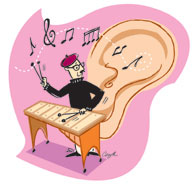A small number
of oxygen radicals in the bloodstream can wreak a lot of havoc. They can
initiate a series of reactions that lead to production of huge numbers
of radicals, starting, in essence, a chemical “bonfire” in the
arteries. Emory cardiologist David Harrison and colleagues are studying
these “kindling” radicals to determine how they can be stopped.
 The
Emory researchers have long studied oxygen radicals and were among the
first to characterize their role in vessel function and in the health
and disease of blood vessels.
The
Emory researchers have long studied oxygen radicals and were among the
first to characterize their role in vessel function and in the health
and disease of blood vessels.
Radicals,
or molecules with unpaired electrons in their structures, are usually
thought of as “bad,” rapidly destroying or altering other molecules
they come in contact with. But within blood vessel walls, nitric oxide
is considered a “good” radical, causing blood vessels to dilate
and maintain low blood pressure. It also prevents many steps leading to
atherosclerosis.
Superoxide
is the arch enemy of nitric oxide. When these two radicals come close
to one another in the vessel wall, nitric oxide is destroyed, and a harmful
radical called peroxynitrite is formed.
The Emory
researchers have found that this encounter between nitric oxide and superoxide
is a major reason why nitric oxide is lost, leading to excessive oxidation
in the vessels, thickening of the vessel wall, and eventual occlusion.
Harrison
has found that lowering cholesterol dramatically reduces superoxide production
and increases levels of nitric oxide in the blood. Two classes of drugs
already used to treat high blood pressure—ACE inhibitors and angiotensin
receptor blockers—reduce superoxide levels in the blood.
“Another
way our bodies rid themselves of superoxide is the enzyme superoxide dismutase,”
says Harrison. “These enzymes are present in all cells and are a
major source of protection against superoxide.”
He and his
colleagues have done studies showing that exercise training in animals
triples the amount of superoxide dismutase in the blood. “The ability
of superoxide dismutase to remove superoxide is 10,000 times more effective
than the common anti-oxidant vitamins C and E,” Harrison says. “This
finding may help explain why frequent exercise has such a beneficial effect
in preventing heart disease.”
The researchers are looking for new ways to detect oxidative stress in humans and to determine whether certain people are more prone to the oxidant process. “We would like to be able to see patients at an early age, detect whether they have markers for excessive free radical production, and then treat them before they develop overt heart disease,” says Harrison. (BACK TO TOP)
 Good
vibes for the hearing impaired
Good
vibes for the hearing impaired
Whether brought on by aging, genetics, or noise, hearing impairment affects about 28 million people in the United States. For many, traditional hearing aids are not a solution. Emory’s Department of Otolaryngology now has something new to offer these patients. The Vibrant Soundbridge is surgically implanted and works by directly vibrating the small bones of the middle ear. Surgery to implant the internal receiver of the device takes up to two hours and heals within two months. An external audio processor worn externally uses digital technology to pick up sound and transmit it to the implanted receiver. Eligible patients must have moderate to severe hearing impairment and have tried traditional hearing aids with unsatisfactory results. (BACK TO TOP)
Copyright © Emory
University, 2004. All Rights Reserved